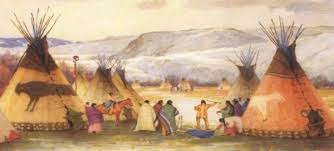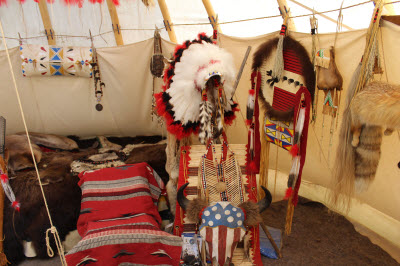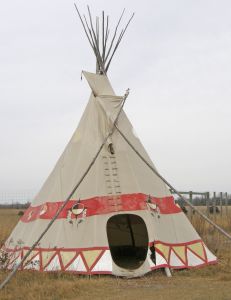A Brief History of the Teepee in North America
Teepees, also known as tepees or tipis are a native American home used and constructed by the plains Indians of North America. Although not thought to be the invention of the plains Indian, that honor reputedly goes to the Indians of the Northern forests, they did further develop them and are the most famous dwellers in them. It is thought the earliest use of the teepee by plains Indians was around the seventeenth century.
Teepees and plains Indians such as the Sioux nation, Arapaho, crow, Cheyenne, Omaha, Osage and Blackfoot tribes were most commonly found on the broad expanse of prairie and steppe which lies east of the Rocky mountains in the USA. This includes partial coverage of the states Colorado, Kansas, Montana, Nebraska, New Mexico, North Dakota, Oklahoma, South Dakota, Texas and Wyoming.
Made traditionally from buffalo hide wrapped around pine lodgepoles in a conical shape the teepee was the ideal home for the Indians. This was because these homes were easy to construct but even easier to dismantle and move around. The plains Indians lived off the land and followed the migration of the buffalo and bison for food and resource purposes. As well as eating these animals they made fires with the dung, food bags, buckets and cooking vessels out of the intestines and the bladder. They also used the sinews as bow strings for hunting and of course the hides for covering their homes. Migrating with the buffalo and bison was extremely important.
Teepees were also the best design of dwelling for the weather conditions of the prairies of North America. Cool in summer and warm in winter due to extra lining stuffed with straw being added, they also had the advantage of being movable so that the strong winds and storms were not blustering through the entrance flap.
The teepee was constructed by first raising three or four poles that would provide the basis of the teepee and form a conical shape. This was then built upon by placing twenty to thirty less heavy poles to complement the original ones. These poles were then tied together securely near the top and buffalo hide secured around the outside. An entrance flap was then cut into the hide that could be left open or closed. This ingenious structuring not only made a secure dwelling but could be taken down in less than an hour to ensure the plains Indians were not far behind the migrating buffalo or bison. These structures were also easy to transport especially since the Spanish had introduced horses to the plains Indians. These enabled the Indians to take down their teepees and use the poles as a kind of sled known as a Travois. This was then attached to a horse and dragged along carrying supplies and or people.
Teepees were the domain of the women, they controlled everything about them from where they were placed, placing and moving them and even refusing or giving permission for their husbands to paint them or not! Usually women would choose to place them so the entrance faced east towards the rising sun. However sometimes weather did not permit this or they would choose to place them in a circle which created a secure kind of courtyard for children to play in and be kept an eye on. It has even been said that despite Indian women having few rights, if they ‘divorced’ their husbands they kept the teepee.
Women were also in charge inside the teepee too and if she said it was time to go to sleep, people went to sleep or they left the teepee. Sleep consisted of lying on buffalo skins on the floor, furniture was limited in a teepee. In fact other than the skins most teepees probably only consisted of a central fire for warmth and cooking and an altar to burn incense on for worship.
Outside the teepee men were in charge and they provided the raw materials to make the teepee. Buffalo, sometimes bison or elk skin was brought by the man after hunting for the exterior and poles were either made by him or traded for. It was quite usual to pay a horse for five poles. Trees were scarce on the plains so poles were a rare and valuable commodity. During cold weather the men also placed an extra piece of hide around the top of the teepee to keep warmth in. Having fires in the center of these dwellings meant the need for an escape for the smoke, and a hole was left at the top of the tent for this purpose. These teepees could often be between twelve and twenty feet tall so placing the extra skin was no easy feat. The men also, with permission of their wives  painted the exterior of the teepees. This was usually done during winter when hunting was limited. Scenes depicted usually included animals, historical battles, celestial bodies and personal achievements.
painted the exterior of the teepees. This was usually done during winter when hunting was limited. Scenes depicted usually included animals, historical battles, celestial bodies and personal achievements.
Ceremony and etiquette in and of the teepee was also extremely important to the plains Indians. Believing that the power of the world worked in circles meant the shape of the teepee was extremely symbolic. They also felt that a fixed home was like a cage and extremely unhealthy, thus the mobility of the teepee gave them freedom and health.
Etiquette wise if the entrance flap to a teepee was open it meant that there was an invitation for people to enter freely. If closed however visitors and people who actually lived there were expected to announce their arrival and await permission to enter. Once inside guests always sat to the left of the head of the family who was always seated furthest away from the entrance. These rules were for everybody and everyone knew them and abided by them.
Nowadays teepees are more commonly used for ceremonial purposes than for dwelling in. Native American families who wish to pass on their heritage and tradition can often be found using them for powwows and ceremonies. They are also used for historical reenactments and by back to the land devotees. Small replica teepees have also become a popular toy for young children as a cubby of sorts to play in either inside the house or in the backyard.
![]()

